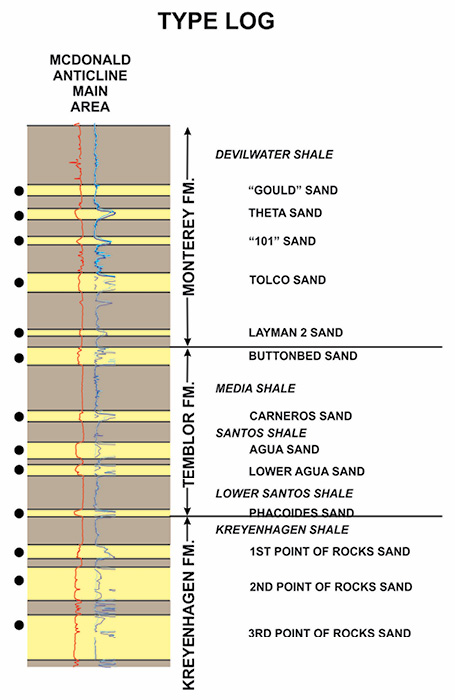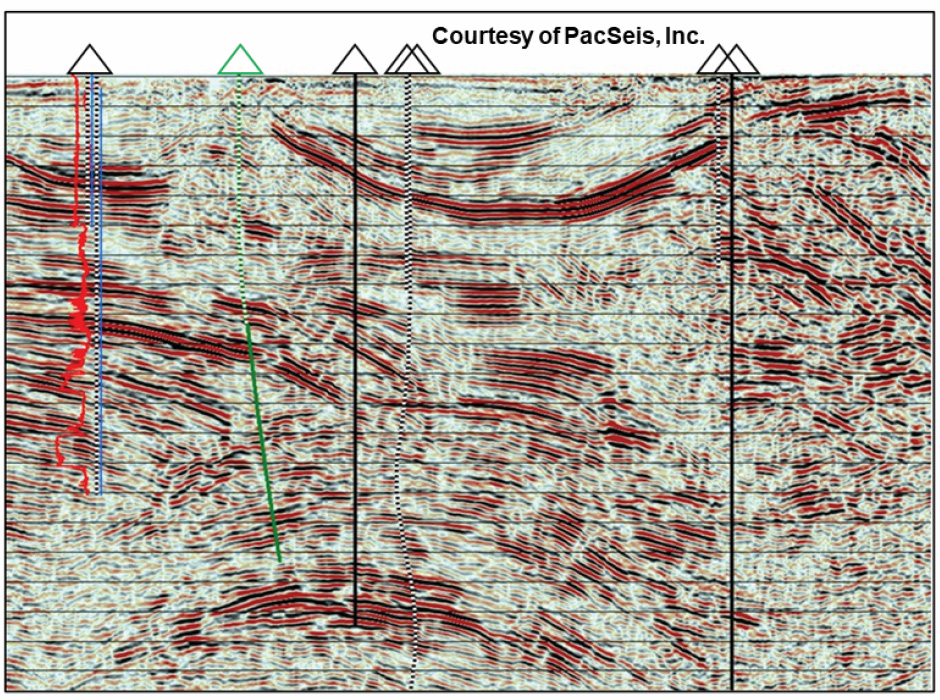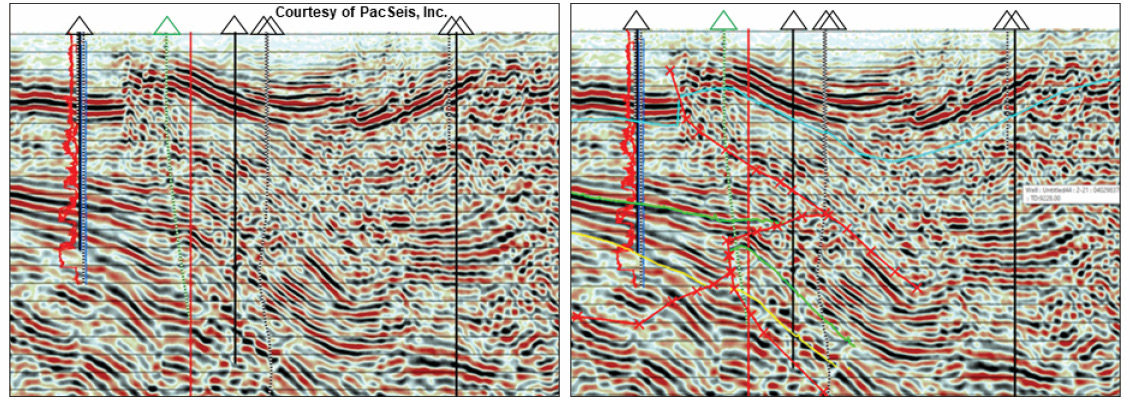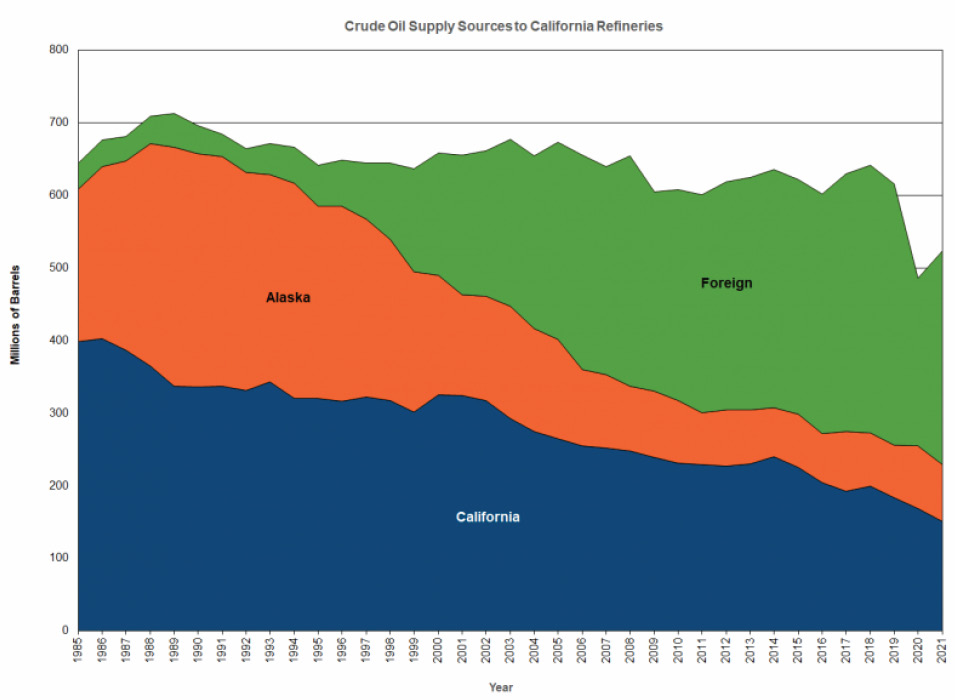West-Side Fold Belt (WSFB)
Images from reprocessed 3D seismic surveys integrated with structural models of convergence yield untested conventional oil prospects and explain dry holes. Exploration risk is generally lower in basins with giant oil fields while complex geology can increase risk and the San Joaquin Basin (SJB, Figure 1) has both. Explored and produced for over 140 years, the SJB has yielded ~17 billion barrels of oil equivalent (Bboe) with at least 5 Bboe yet to be produced (Neher, 2018).
Here, we focus on new exploration opportunities, in the tens of millions barrel range, along the WSFB using a recently reprocessed 3D seismic survey (TRICON 5, 2022) and structural geology-based mapping. Most oil discoveries of the last five decades in the SJB have occurred in the WSFB. The WSFB developed along and contemporaneously with the San Andreas fault (SAF) plate-boundary and its true structural style, a fold and thrust belt (F&TB), has been recognised only during the last four decades (Namson and Davis, 1988; Davis and Namson, 2017). Use of the F&TB structural style in seismic mapping reveals untested prospects and explains many dry holes. However, the F&TB concept arrived late in the basin’s long exploration history and remains underutilised. Within the WSFB are several giant oil fields and numerous large to medium-sized oil fields with a wide array of anticlinal, fault, and stratigraphic-trapping mechanisms (Figure 2) that have resulted from nearly non-stop deformation and deposition during the Neogene.
Geologic complexity is both an exploration challenge and an opportunity where smaller traps can be poorly imaged, overlooked, and difficult to pinpoint. Improved seismic imaging and structural mapping are key to future success. In the WSFB there are numerous oil fields with 1–50 MMbo recoverable with only 10s to 100s of acres of extent, yet these small areas yield large volumes due to multiple, stacked reservoirs and seals (Figure 3).
San Joaquin Super Basin
The American Association of Petroleum Geologists (AAPG) classify the SJB as a Super Basin i.e., >5 Bboe (Neher, 2018). A USGS, 2003, assessment of undiscovered, recoverable, conventional hydrocarbons in the SJB has an estimated mean of 1.8 trillion cubic feet of gas, 393 million barrels of oil, and 86 million barrels of natural gas liquids. The SJB has several organic-rich and thermally mature source rock intervals that include the Monterey Formation, a world-class oil source rock that provides 86% of the estimated ultimate oil recovery in the basin (Neher, 2018; Isaacs and Rullkoetter, 2001). Numerous, highly productive clastic and fractured shale reservoirs span the geologic column from Cretaceous to the Quaternary. Within the WSFB are six of the nation’s top 100 producing oil fields: Coalinga, Lost Hills, South Belridge, Cymric, Midway-Sunset, Elk Hills, plus numerous lesser oil fields.
Structural Models, a Key Interpretation Tool
Fault-related fold models that illustrate the development of petroleum traps and structures are frequently used to assist seismic and cross-section mapping and interpretations in structurally complex F&TBs (Namson and Davis, 1988). Worldwide, numerous petroleum-rich provinces are situated in convergent strike-slip belts with giant petroleum traps such as the WSFB (Davis and Namson, 2017).Before the 1980s the WSFB’s structural style was attributed to wrench faulting that produced steepening-with-depth fault patterns in cross-section with limited sub-fault exploration areas. Subsequent efforts by the Atlantic-Richfield Company (ARCO) in the Cuyama Basin, CA (Davis et al., 1988), the 1983 Coalinga earthquake (Namson and Davis, 1988), and the discovery of strain-partitioning adjacent to the SAF plate-boundary (Mount and Suppe, 1987; Zoback et al., 1987) show the WSFB and other CA oil basins have a F&TB structural style. Thus, the WSFB and other CA oil basins have extensive under-explored areas, with known oil source and reservoir rocks, where detachments and thrust sheets conceal footwalls with untested traps (Figure 2, below; Davis, 2015) and in Cuyama, a previously unknown oil and gas sub-basin proven by deep drilling (Davis et al., 1988). Here, we show a 2D seismic line with dry holes (Figure 4) and contrast its trap image with the TRICON 5’s 3D images that are integrated with the F&TB structural-style mapping (Figures 5 & 6, below). This approach accounts for previous exploration failures and identifies an untested prospect. The significant improvement in the reprocessed data quality is a result of a new term noise attenuation workflow where the data are sorted in five different domains with noise attenuation applied in each domain.
Future of Oil in California and CO2 Emissions
California oil demand has remained constant over nearly four decades (Figure 7), it is the second-largest consumer of petroleum products in the nation, and the largest consumer of gasoline and jet fuel (EIA, 2021). The SJB and CA’s other oil-rich basins remain an important crude oil source to CA’s refineries despite declining in-state production. For at least the next several decades CA will remain a sizeable oil market and the SJB will be its most important domestic source despite concerns and policies to address climate change.
This market has an indispensable role in CA’s energy mix and has decades of high demand that show no sign of decreasing (Figure 7). Counter-intuitively, CA’s present anti-fossil fuel politics and policies have increased its per-barrel CO2 emissions by reliance on an ever-increasing supply of maritime-transported oil (Figure 7, Olmer et al., 2017), plus raising the risk of oil spills at sea and onshore oil leakage at foreign sources with questionable environmental records. It is politically unlikely that CA’s public and businesses, while concerned about climate change, will support a dramatic oil supply reduction with its negative economic impact and life-style restrictions while also becoming a national security risk (Rapier, 2019). CA will need to adjust its counter-productive policies by allowing more in-state oil production and exploration that will support a smoother, more practical energy transition over the next four or five decades.
References
- CAEC, 2021, California Energy Commission, https://www.energy.ca.gov/data-reports/energy-almanac/californias-petroleum-market/oil-supply-sources-california-refineries
- EIA, 2021, California State Energy Profile, US Energy Information Administration, https://www.eia.gov/state/print.php?sid=CA
- Davis, T. L., M. B. Lagoe, W. J. M. Bazeley, S. Gordon, K. McIntosh, and J. S. Namson, 1988, Structure of the Cuyama Valley, Caliente Range, and Carrizo Plain and its significance to the structural style of the southern Coast Ranges and western Transverse Ranges, in W. J.M. Bazeley ed., Tertiary tectonics and sedimentation in the Cuyama basin, San Luis Obispo, Santa Barbara, and Ventura Counties, California, Pacific Section SEPM, v. 59, p. 141–158.
- Davis, T. L., 2015, Study shows evidence for untested large traps, San Joaquin basin, California: Oil & Gas Journal, v. 113, no. 10, p. 42–50.
- Davis, T.L., and J.S. Namson, 2017, Field excursion: Petroleum traps and structures along the San Andreas convergent strike-slip plate boundary, California: AAPG Bulletin, v. 101, No.4, p. 607-615.
- Isaacs, C. M., and Rullkoetter, J., eds., 2001, The Monterey Formation: From rocks to molecules: Columbia University Press, New York, NY, United States: 553 pp
- Mount, V. S., and J. Suppe, 1987, State of stress near the San Andreas fault: Implications for wrench tectonics: Geology, v. 15, p. 1143–1146, doi:10.1130/0091-7613(1987) 15<1143:SOSNTS>2.0.CO;2
- Namson, J. S., and T. L. Davis, 1988, Seismically active fold and thrust belt in the San Joaquin Valley, central California: Geological Society of America Bulletin, v. 100, p. 257–273, doi:10.1130/0016-7606(1988)100<0257:SAFATB> 2.3.CO;2.
- Neher, K. 2018, San Joaquin Basin, California, Super Basin: Past, Present and Future San Joaquin Geological Society December 2018, SJGS Meeting & Presentation: https://www.searchanddiscovery.com/abstracts/html/2019/longbeach-90339/abstracts/2019.PS.15.html
- Olmer, N., Comer, B., Roy, B., Mao, X., Rutherford, D., 2017, Greenhouse Gas Emissions from Global Shipping, 2013-2015, International Council on Clean Transportation (ICCT), https://theicct.org/sites/default/files/publications/Global-shipping-GHG-emissions-2013-2015_ICCT-Report_17102017_vF.pdf
- Rapier, R., 2019, California’s Oil Hypocrisy Presents A National Security Risk https://www.forbes.com/sites/rrapier/2019/06/21/californias-oil-hypocrisy-presents-a-national-security-risk/?sh=2d9c2839252a
- TRICON 5, 2022, Tricon Geophysics, Inc., http://tricongeophysics.com/products-and-services/time-processing/
- United States Geological Survey (USGS), 2003, Petroleum Systems and Geologic Assessment of Oil and Gas in the San Joaquin Basin Province, California, Professional Paper 1713, https://pubs.usgs.gov/pp/pp1713/01/pp1713_ch01.pdf
- Zoback, M. D., M. L. Zoback, V. S. Mount, J. Suppe, J. P. Eaton, J. H. Healy, D. Oppenheimer, et al., 1987, New evidence on the state of stress of the San Andreas fault system: Science, v. 238, p. 1105–1111, doi:10.1126/science.238.4830.1105.












